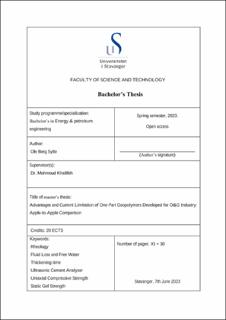| dc.contributor.advisor | Khalifeh, Mahmoud | |
| dc.contributor.author | Berg Sylte, Ole | |
| dc.date.accessioned | 2023-08-18T15:51:19Z | |
| dc.date.available | 2023-08-18T15:51:19Z | |
| dc.date.issued | 2023 | |
| dc.identifier | no.uis:inspera:129762885:68265908 | |
| dc.identifier.uri | https://hdl.handle.net/11250/3084874 | |
| dc.description.abstract | The development of geopolymers for use in the oil and gas industry has gained significant recognition in recent years due to the pressing need for sustainable and environmentally friendly alternatives in the sector. The oil and gas industry has a significant impact on the environment, and the cementing in oil and gas operations contribute to a large part of the total emissions. Geopolymers, on the other hand, offer a viable solution that not only reduces the environmental impact but also offers improved performance and cost-effectiveness.
This work addresses evaluation of a one-part granite-based geopolymer developed for O&G industry, with focus on well construction and well abandonment. To evaluate potential of the technology, a comparison is done with neat API class G cement. The evaluation includes essential tests defined by API RP 10B-2 such as free water and fluid loss, thickening time, viscosity, sonic strength, uniaxial compressive strength, and static gel strength.
In this study of geopolymers, I made notable findings regarding its characteristics and challenges. One key observation is the difficulty in mixing. Consistency tests revealed that after mixing, the geopolymer will be thicker in the beginning, then gets thinner with shearing. This finding presents challenges in achieving desired workability.
Additionally, the study examined the fluid retention properties of geopolymers compared to conventional cement (OPC). Geopolymers showed relatively good fluid retention, although not meeting the standard requirements. This indicates a need for further research to improve fluid retention capabilities.
Another significant finding is the absence of free water in geopolymer samples. This suggests that water used in the mixture becomes chemically bound during geopolymerization, contributing to its strength and durability.
Overall, these findings offer valuable insights into the behavior and properties of geopolymers in the oil and gas industry. While challenges in mixing consistency and fluid retention exist, the absence of free water highlights the potential of geopolymers as sustainable alternatives. Further research and optimization efforts can unlock enhanced performance and broader applications. | |
| dc.description.abstract | The development of geopolymers for use in the oil and gas industry has gained significant recognition in recent years due to the pressing need for sustainable and environmentally friendly alternatives in the sector. The oil and gas industry has a significant impact on the environment, and the cementing in oil and gas operations contribute to a large part of the total emissions. Geopolymers, on the other hand, offer a viable solution that not only reduces the environmental impact but also offers improved performance and cost-effectiveness.
This work addresses evaluation of a one-part granite-based geopolymer developed for O&G industry, with focus on well construction and well abandonment. To evaluate potential of the technology, a comparison is done with neat API class G cement. The evaluation includes essential tests defined by API RP 10B-2 such as free water and fluid loss, thickening time, viscosity, sonic strength, uniaxial compressive strength, and static gel strength.
In this study of geopolymers, I made notable findings regarding its characteristics and challenges. One key observation is the difficulty in mixing. Consistency tests revealed that after mixing, the geopolymer will be thicker in the beginning, then gets thinner with shearing. This finding presents challenges in achieving desired workability.
Additionally, the study examined the fluid retention properties of geopolymers compared to conventional cement (OPC). Geopolymers showed relatively good fluid retention, although not meeting the standard requirements. This indicates a need for further research to improve fluid retention capabilities.
Another significant finding is the absence of free water in geopolymer samples. This suggests that water used in the mixture becomes chemically bound during geopolymerization, contributing to its strength and durability.
Overall, these findings offer valuable insights into the behavior and properties of geopolymers in the oil and gas industry. While challenges in mixing consistency and fluid retention exist, the absence of free water highlights the potential of geopolymers as sustainable alternatives. Further research and optimization efforts can unlock enhanced performance and broader applications. | |
| dc.language | eng | |
| dc.publisher | uis | |
| dc.title | Advantages and Current Limitation of One-Part Geopolymers Developed for O&G Industry: Apple-to-Apple Comparison | |
| dc.type | Bachelor thesis | |
